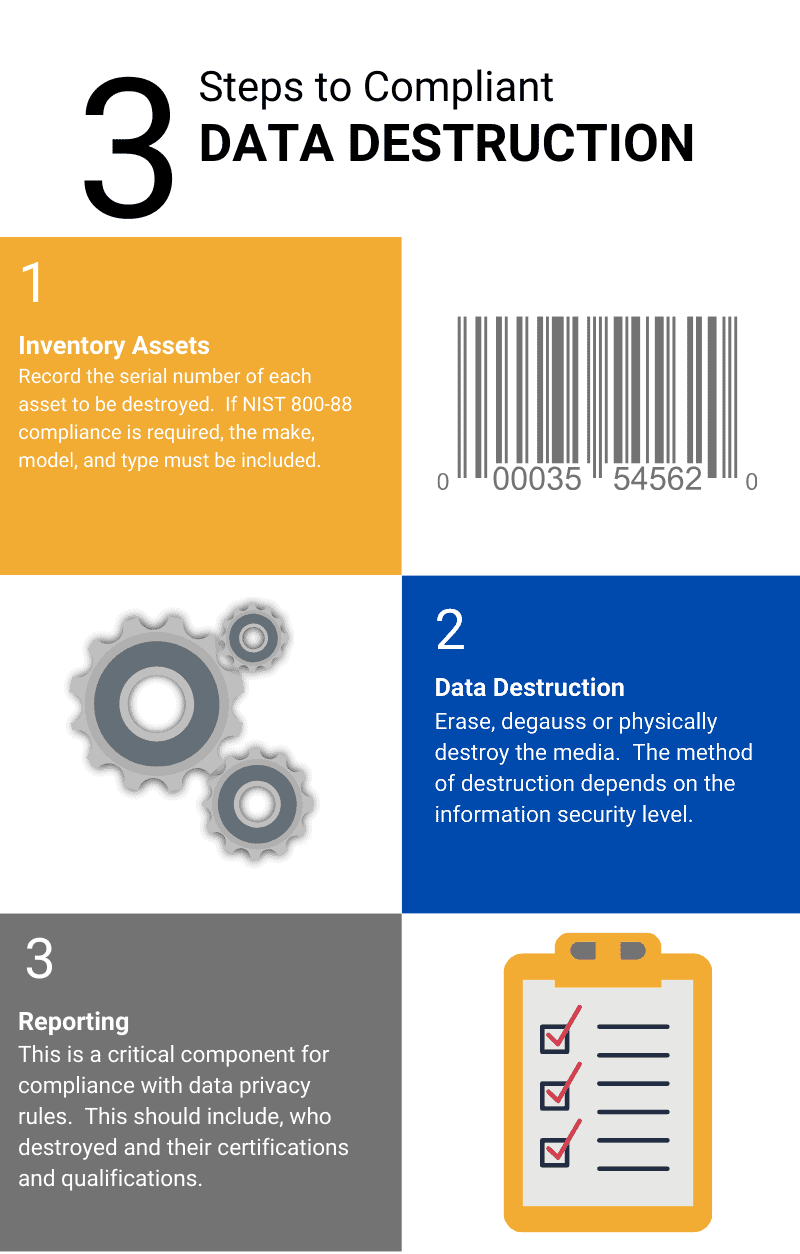Understanding the Role of Data Destruction in Strengthening Cyber Security Defenses
Understanding the Role of Data Destruction in Strengthening Cyber Security Defenses
Blog Article
The Importance of Effective Data Damage Practices in Shielding Sensitive Details and Ensuring Computer System Security
In a period where information breaches are increasingly usual, the significance of effective information damage methods can not be overstated. Applying robust information damage methods not just mitigates these threats but additionally aligns with lawful compliance needs, guaranteeing that companies support their reputation and foster customer trust.
Comprehending Information Damage
Recognizing data damage is essential in today's electronic landscape, where delicate information can quickly be compromised. Efficient information devastation involves not simply removing files however making certain that data is irretrievable via comprehensive techniques. This procedure is essential for organizations that take care of confidential customer details, intellectual property, or internal papers, as any kind of violation can result in serious economic and reputational consequences.
Information destruction encompasses different methods, consisting of shredding physical media, degaussing magnetic storage devices, and utilizing software-based options that overwrite information multiple times. Each technique serves a details purpose and has to line up with the level of sensitivity of the information being disposed of. For instance, physical devastation is frequently liked for hard drives having highly confidential data, while software application techniques could be sufficient for much less delicate info.
In addition, sticking to market requirements and policies, such as the General Data Protection Law (GDPR) or the Wellness Insurance Policy Transportability and Liability Act (HIPAA), is critical for conformity and to reduce legal dangers. Organizations must create a durable data devastation policy, train employees on ideal methods, and consistently audit their treatments to ensure that all delicate information is taken care of securely and effectively.
Dangers of Inadequate Practices
Inadequate data damage techniques subject companies to considerable dangers that can have significant effects. When sensitive details is not correctly disposed of, it stays susceptible to unapproved access, which can bring about data violations and identification theft. Such occurrences not only jeopardize the protection of individuals yet also stain the organization's online reputation, resulting in a loss of customer count on and possible financial consequences.
In addition, regulatory compliance is progressively rigorous in numerous markets. Failing to follow data damage guidelines can cause hefty fines and lawsuits versus companies. These penalties can strain funds and draw away attention from core company procedures.
Furthermore, the misuse of residual information can bring about intellectual residential property burglary or company espionage, jeopardizing affordable benefits (data destruction). The impact of insufficient data damage expands past immediate financial losses; it can likewise cause long-lasting damages to brand name honesty and market position

Organizations need to recognize that data safety is not only about avoiding violations; it additionally encompasses the accountable monitoring of information throughout its lifecycle. Neglecting effective data devastation protocols can have devastating ramifications, highlighting the requirement for durable procedures to alleviate these dangers.
Finest Practices for Data Devastation
Implementing effective data damage techniques is important for protecting sensitive information and keeping compliance with governing standards. Organizations ought to embrace a multi-faceted strategy to make sure that data is irretrievable, thus protecting against unauthorized gain access to and possible violations.
First, data must be classified based upon level of sensitivity, allowing organizations to apply appropriate damage approaches tailored to the level of risk. For digital data, utilizing software-based data-wiping devices that adhere to market standards can effectively overwrite existing data. Physical destruction methods, such as shredding or degaussing, are crucial for gadgets that store sensitive details, making sure full removal.
Developing a clear data retention plan is vital, outlining just how long different kinds of details ought to be maintained prior to destruction. Routine audits of information storage systems are likewise essential to identify out-of-date or unneeded information requiring removal.
Moreover, training staff members on the importance of data devastation and the details procedures to adhere to fosters a culture of safety and security within the company. Ultimately, maintaining paperwork of information devastation processes offers responsibility and sustains conformity with exterior policies and interior plans. By sticking to these best methods, companies can dramatically mitigate the risks related to data exposure.
Legal and Conformity Factors To Consider

Failing to abide by these guidelines can cause severe charges, consisting of significant penalties and reputational damage. Organizations should carry out a durable information destruction policy that lines up with these lawful structures and gives clear standards on the correct approaches of data disposal, whether physical shredding or digital wiping.
Furthermore, preserving documents of information devastation tasks is essential for demonstrating compliance during audits or evaluations. By prioritizing legal and compliance considerations, organizations can improve their data safety and security position and foster depend on with customers and stakeholders, eventually adding to a much more safe data administration atmosphere.
Benefits of Effective Data Destruction
Reliable information devastation methods prolong beyond mere compliance; they offer substantial benefits to companies that prioritize them. By making sure that sensitive information is irretrievably destroyed, companies minimize the danger of data breaches and the possible economic consequences connected sites with them. This proactive strategy not just safeguards against unauthorized accessibility yet likewise improves the overall reliability of the company in the eyes of stakeholders and customers.
Applying robust data devastation techniques, such as physical destruction of storage space devices or innovative information wiping strategies, contributes to the strengthening of a company's cybersecurity position. data destruction. It reduces the chance of copyright theft and protects exclusive information, therefore preserving an affordable edge in the market

Conclusion
In conclusion, reliable information destruction techniques are necessary for securing sensitive details and improving overall computer system safety and security. Ultimately, a dedication to robust information damage strategies cultivates a culture of duty, consequently reinforcing an organization's cybersecurity posture and preserving client depend on.

Report this page